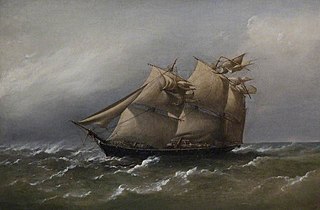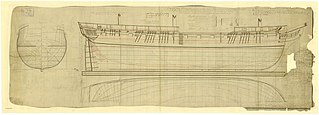
HMS Rose was a 20-gun Seaford-class post ship of the Royal Navy, built at Blaydes Yard in Hull, England in 1757 and in service until 1779. Her activities in suppressing smuggling in the colony of Rhode Island provoked the formation of what became the Continental Navy, precursor of the modern United States Navy. She was based at the North American station in the West Indies and then used in the American Revolutionary War. A replica was built in 1970, then modified to match HMS Surprise, and used in two films, Master and Commander: Far Side of the World and Pirates of the Caribbean: On Stranger Tides.

HMS Kingfisher was a Doterel-class screw sloop of the Royal Navy. She was built at Sheerness Dockyard and launched on 16 December 1879. She conducted anti-slavery work in the East Indies in the late 1880s before being re-roled as a training cruiser, being renamed HMS Lark on 10 November 1892, and then HMS Cruizer on 18 May 1893. She was sold in 1919.

HMS Daring was a 4-gun Fantome-class sloop of the Royal Navy. She was launched in 1874 and sold for breaking in 1889 after serving most of her career in the Pacific.

HMS Milan was a 38-gun fifth rate frigate of the Royal Navy. She had previously been Ville de Milan, a 40-gun frigate of the French Navy, but served for only a year before being chased down and engaged by the smaller 32-gun frigate HMS Cleopatra. Ville de Milan defeated and captured her opponent, but suffered so much damage that she was forced to surrender without a fight several days later when both ships encountered HMS Leander, a British fourth rate. Milan went on to serve with the Royal Navy for another ten years, before being broken up in 1815, after the conclusion of the Napoleonic Wars.

HMS Ferret was a Royal Navy Cruizer-class brig-sloop built by Benjamin Tanner at Dartmouth and launched in 1806, 19 months late. She served on the Jamaica, Halifax, and Leith stations during which time she took three privateers as prizes before she was wrecked in 1813.
HMS Saracen was a Royal Navy Cruizer-class brig-sloop built by Perry, Green & Wells at Blackwall Yard and launched in 1804. She had a relatively short and uneventful career before she was broken up at Chatham in 1812.

HMS Fawn was a Royal Navy 17-gun Cruizer-class sloop launched in 1856. She served on the Australia, North America and Pacific stations before being converted to a survey ship in 1876. She was sold and broken up in 1884.

HMS Emulous was a Royal Navy 18-gun Cruizer-class brig-sloop, built by William Row at Newcastle and launched in 1806. She survived an inconclusive but bloody battle with a French frigate during the Napoleonic Wars and captured a number of prizes, including two privateers, on the Halifax station during the War of 1812 before she was wrecked in 1812.
Only one vessel of the Royal Navy has borne the name HMS Colibri, after the Colibri, a genus of hummingbird. There was to be a second vessel of the same name but she was never completed. The two vessels were:

HMS Orpheus was a 36-gun Apollo-class fifth-rate frigate of the Royal Navy launched in 1809 from Deptford Dockyard. She was broken up in 1819.
HMS Pigeon was a 10-gun Cherokee-class brig-sloop built for the Royal Navy during the 1820s. She was sold in 1847.
HMS Partridge was a 10-gun Cherokee-class brig-sloop built for the Royal Navy during the 1820s. She was sold in 1864.
HMS Wizard was a 10-gun Cherokee-class brig-sloop built for the Royal Navy during the 1820s. She was wrecked in 1859.

HMS Harrier was an 18-gun Fly-class sloop, built for the Royal Navy during the 1830s.

HMS Lily was a 16-gun Racer-class brig-sloop built for the Royal Navy during the 1830s.

HMS Harlequin was a 16-gun Racer-class brig-sloop built for the Royal Navy during the 1830s.
HMS Grecian was a sixteen-gun Acorn-class brig-sloop built for the Royal Navy during the 1830s.
The Snake-class ship-sloops were a class of four Royal Navy sloops-of-war built in the late 18th and early 19th centuries. Though ships of the class were designed with the hull of a brig, their defining feature of a ship-rig changed their classification to that of a ship-sloop rather than that of a brig-sloop.
Gordon Thomas Falcon was an officer in the Royal Navy. He first went to sea in 1794 as an able seaman on board HMS Sheerness. Quickly promoted to midshipman, Falcon transferred to HMS Repulse and then HMS Venerable, Admiral Adam Duncan's flagship, in which he served at the Battle of Camperdown.
Vice-Admiral Philip Wodehouse was a Royal Navy officer. A son of John Wodehouse, 1st Baron Wodehouse, he joined the navy some time before 1794. In 1796 he was promoted to commander and then captain, commanding sloops and frigates in the Mediterranean Fleet. Wodehouse cycled through a series of frigate commands towards the end of the French Revolutionary Wars, including HMS Mignonne which he had to burn as useless in 1797. In 1803, while commanding HMS Resistance, his ship was wrecked off Cape St Vincent. Wodehouse subsequently commanded several ships of the line, including HMS Cumberland in the Mediterranean where in 1809 he fought at the Battle of Maguelone. Wodehouse was appointed Resident Commissioner, Halifax, in 1811 and served there until the dockyard was closed in 1819. He was promoted to rear-admiral later in the year. Wodehouse saw no further active service, but was promoted to vice-admiral in 1830.










